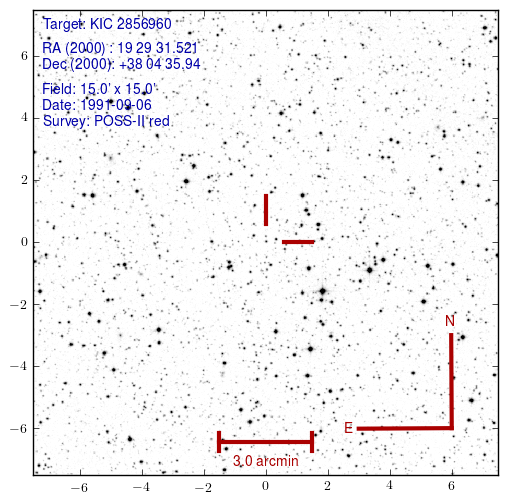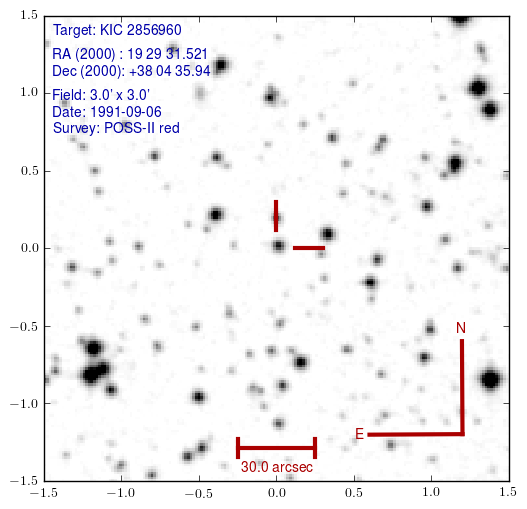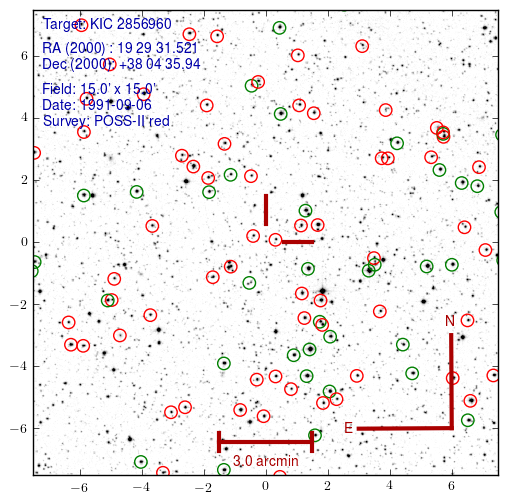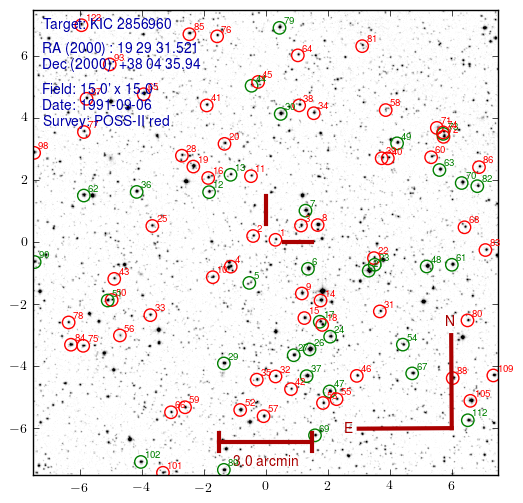
Update on KIC: the good news is that results are starting to come in and we have definitely detected the tertiary events, so they are still occurring, which is progress in itself. Some of the data clearly indicate that my model needs adjusting. At the moment I don't know if this is within the range of uncertainties or not. See for example these BVRI data taken by Elena Pavlenko and Aleksei Sosnovskij in Crimea (B bottom, I top). I think that the two eclipses in my model have merged into one, which can happen according to the relative position of the binary and third star. Events have also been seen in the US and Europe. It may just be a case of a little tweaking. We will see; the big problem still remains of course, but I want to get everything in order first before I think about this. One nice feature of the multi-colour data is that I think the binary eclipses may be apparent in the I-filter (see the dip at the start of the top light curve). This is what I had hoped given the probability that the binary is composed of a pair of M stars. It means that the binary could be accessible to e.g. timing studies from the ground.
 |
Left: The Kepler light curve of KIC 285690 shows a fuzzy appearance owing to the primary and secondary eclipses of a 6 hour binary along with sharp drops on flux marking the tertiary eclipses of the binary crossing the face of a third star. The insets show blown-up views of two of these events, the second of which was observed in Kepler's 1-minute short cadence mode. You can also see the binary eclipses away from the tertiary eclipse dips. (Figure taken from the model paper.) |
The aim of this page is to encourage and help observations to diagnose what might be going on in this puzzling triple star.
Last year I and collaborators tried to model a remarkable star found in the Kepler field, known as KIC 2856960. This star features the eclipses of a close binary with a period just over 6 hours, along with "tertiary events" that recurr every 204 days when the binary passes in front of a third star (see above). KIC 2856960 thus appears to be a triple star consisting of a tight probably circular-orbit binary which is in turn in a much wider (eccentric) orbit with another star. Such arrangements are rare but of high interest for their potential harvest of precision stellar parameters. Initially confident that we would be able to model these events, we found to our surprise that we simply couldn't. We wrote up this failed modelling attempt in a paper, titling it the "impossible" star, reflecting the current impossibility of modelling (clearly nature does not find it impossible).
Sadly, the original Kepler survey was brought to an end by a failure of one of Kepler's reaction wheels in May 2013. This was doubly sad for KIC 2856960 since the failure occurred a matter of days before another tertiary event was expected. Since then, as far as I am aware, there have been no observations of the tertiary events of this star, which means that the last one observed was in 2012 by Kepler. All is not lost however, and we are continuing to follow-up this object in an effort to understand it, mainly through spectroscopy, but there is also value in ground-based photometry, particularly in August 2015, as I now explain.
Triple systems evolve dynamically, so that, for instance, orbital inclinations change, and so we can't even be sure that the tertiary events in KIC 2856960 still occurr. The next predicted tertiary eclipses are due to take place in the period August 9 to 10, 2015 when KIC 2856960 is observable for much of the night from the northern hemisphere. This page is to help observers to cover it and also to try to coordinate observations (see the form below). Although it won't be possible to match Kepler from the ground, ground-based observations are certainly capable of detecting the 5 to 8% dips in flux that occur during the tertiary events, and in any case Kepler can no longer see the star. Simply detecting that the tertiary events are still occuring will be progress, but we may also see significant evolution in their form.
Some useful links:
KIC 2856960 can be found at RA=19 29 31.521, Dec=+38 04 35.94 (J2000). SDSS filter magnitudes from SIMBAD are g=16.437, r=15.553, i=15.263, giving reddish colours reflecting the dominant cool star (V is intermediate between SDSS g and r). Here are two finding charts with 15' and 3' fields respectively:


Several people have asked about comparison stars. First of all, please try to
observe as many comparisons as possible as this is useful in combatting
extinction effects. I used the Kepler input catalogue (KIC) to select stars
with Kepler magnitudes brighter than 14 (cf 15.6 for KIC 2856960) and
green/red (g-r) colours the same to within +/-0.25 mags. These are plotted in
green in the charts below. Secondary comparisons brighter than 14.5 with g-r
colours within 0.4 mags of KIC 2856960 are plotted in red.



I suggest that if you can't cover anything else, then try to include stars 6 and 7 as well as the target in your field of view. Here is a list of KIC ids labelled by the numbers used on the above plots. Please let me know if you spot errors or know the stars to be variable (although bear in mind how variable since practically every star is variable at Kepler precision).
Below is the light curve predicted according to the model developed for last year's paper. It comes with the huge caveat that the model cannot be right! If the prediction is right in terms of time at least then we should be in the middle of the tertiary events at about 22:00 UT on 9 August, and the dips should last from around 12:00 on 9 August until about 10:00 on 10 August. However, I would not be at all surprised if this prediction is quite far off, and one might find for instance that the very shallow dip at around 1.35 on the X-scale (08:40 on 9 Aug) could turn out to be deeper than expected for instance. Therefore we really want as intensive coverage as possible over the whole interval shown, and perhaps a day or so earlier in the lead up just in case things are really far off. In any case if anyone does observe the dips on one night, it is important to observe again on a night unaffected by dips with an identical setup in order to provide a benchmark against which to judge the data taken during dips, and of course it would be wise in any case to have some practice runs in the lead up to the main event.
NB. The persistent small dips are the primary and secondary eclipses of the close binary alone. Detection of these with a small telescope is a challenge, but I encourage people to try. It may be easiest to see them with an I filter because the (presumed) M-type dwarfs of the close binary will contribute a larger fraction of the light relative to the K-type third star in I than at shorter wavelengths. The eclipse depths in I will be a useful constraint upon the stars in the close binary.

The timescale is MJD (Modified Julian Day) = JD - 2400000.5. This is an exact integer at midnight UT, not midday. Thus the centre of the above plot (2 on the x-axis) represents midnight UT as the date changes from 09 to 10 August.
The prediction presents an optimistic view of what you will see of course.
Here is a slightly more realistic idea (5 hours, 2 minute cadence at
signal-to-noise 100 per point):

In case you are wondering whether this was a dotting the i's and crossing the
t's exercise of refining some pretty good model, here is the "best fit" I can
come up with at the moment using a physically consistent triple model (the one
above involves a quadruple which I have little faith in)

Although you can see that the model has some elements sort of right, its
pretty hopeless as a fit: something is not right.
The problem with a triple is that Kepler's laws keep the inner binary
too small compared to the outer triple orbit to match the light curves.
Either the inner binary has to be wider apart, or the binary has to cross
the face of the K star more slowly than expected. This was why in the paper I
dragged in a fourth star to make a quadruple, but this model is horribly
contrived and unconvincing.
We need round-the-clock (which means round the globe) coverage of KIC 2856960 over the interval shown in the above plot which extends from 16:50, Aug 8 until 07:10, Aug 11, with the main action predicted to run from 12:00, Aug 9 until 09:40, Aug 10 (all times are UT). To be safe, full coverage of Aug 8 to 11 is desirable. CCD photometry is needed as the variations are only ~6% deep. The events are synchronised to the orbit of the 6 hour binary which means that they occur at a relatively sedate pace and should be well within the reach of many observers. The ideal observations would be to acquire the star as early as possible, and then simply take a time-series of observations for as long and as uniformly as possible until the star is no longer visible. Exposure times from ~10 to 600 seconds should be fine (but obviously use short enough exposures to avoid image trailing and/or saturation, and long enough to avoid too much deadtime between exposures). If possible a colour filter should be used to reduce the effect of colour difference between stars. R is best I think; I or V good alternatives, but filterless ("clear") data are better than none.
One thing Kepler did not deliver was any colour information so I hope to coordinate filters, especially for observers who are likely to overlap in time, as colours could deliver new insights into what is going on in this puzzling system, hence I encourage people to enter their observations into the form below. Unless such coordination is occurring, for consistency, I suggest using an R filter if available.
We are acquiring spectra to measure the radial velocity of the companion K
star. This will allow us to refine the wide orbit parameters and measure the
masses of the binary (total) and the K star. If any one can contribute to this
effort (I realise this will be too difficult for most of course), the period
leading up to and especially following the tertiary eclipse is the most
interesting one to cover, as the predicted RV of the third star shown below
illustrates (very non-sinusoidal because of high eccentricity):

An important thing to realise when contemplating obtaining radial velocities is that each separate instrument has its own offset and so can only contribute to the final fit in a differential sense. i.e. a single RV from a given instrument has no value, there must always be at least two (preferably more, and preferably taken far enough apart for there to be large changes in RV). A single instrument can only be assumed to be "single" if it is kept as fixed as possible of course. Offsets can come from multiple sources, but for cross-correlation RVs, mis-matches in spectral type between the target and reference will automatically lead to an offset that depends upon the wavelength range and resolution for instance. Reflecting this, the prediction plotted above is not absolute, but is referenced relative to the system's centre of mass velocity.
This system is a big puzzle. It seems simple, but we just can't fit it with a physically consistent model. The key question is how can we match the duration and shapes of the tertiary eclipses without making the close binary too wide? We need ideas as well as data!